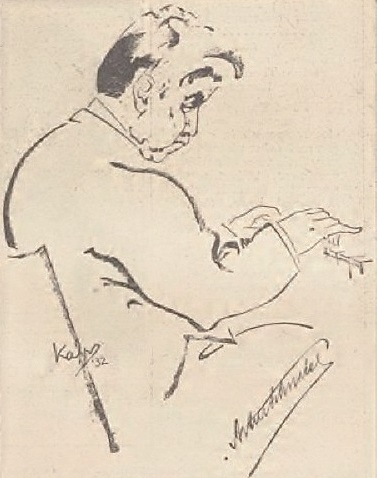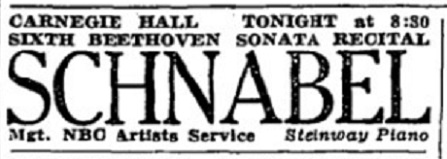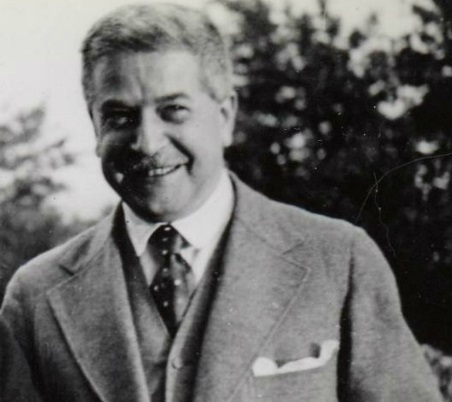
Schnabel – Beethoven Sonates – VI/VII – Sonates n°13 Op.27 n°1 – n°21 Op.53 – n°20 Op.49 n°2 – n°30 Op.109
Sonate n°13 Op.27 n°1: 1 Novembre 1932
Sonate n°21 Op.53: 25 Avril & 7 Mai 1934
Sonate n°20 Op.49 n°2: 12 Avril 1933
Sonate n°30 Op.109: 7 Mai 1932
Artur Schnabel, piano
London Abbey Road Studio n°3 – Engineer: Edward Fowler – piano: Bechstein
Source: disques 33 tours « The HMV Treasury »

Schnabel London 1932
Le sixième programme de l’intégrale des 32 Sonates de Beethoven par Artur Schnabel était beaucoup plus court (68′) que le précédent (100′), mais il proposait une très grande Sonate (n°21 Op.53 « Waldstein » & n°32 Op.109) à la fin de chaque partie. La Sonate n°21 Op.53 est la dernière œuvre qu’il a jouée en public (concert du 20 janvier 1951 au Hunter College de New York).
Pour plus de détails sur les sept récitals de cette intégrale, cliquer ICI
Une des caractéristiques du jeu de Schnabel, qui n’a pas été soulignée par les critiques new-yorkais, mais que l’on perçoit très bien sur ces reports, est la beauté des pianissimi, remarquables aussi bien par la qualité du timbre que par leur densité de son.

Pour le sixième récital, donné le 19 février 1936 à Carnegie Hall, Howard Taubman remarque que Schnabel a bien rendu le caractère enchanteur et romantique de la sonate en si bémol majeur (n°13 Op.27 n°1) et a joué la modeste sonate en sol majeur (n°20 Op.49 n°2) avec la légèreté et le charme qui conviennent à son expression sans apprêt. ‘Mais, c’est avec les deux autres sonates que Mr. Schnabel était confronté au plus grand Beethoven, et c’est dans celles-ci que ses interprétations avaient l’incandescence et la profondeur dignes du compositeur. Le mouvement qui ouvre la sonate en do majeur (n°21 Op.53) était pris un peu plus rapidement que la plupart des pianistes. La puissance et le joie de vivre de la musique justifient cete option, dans la mesure où une allure impétueuse ne mène pas à rendre confus les passages vertigineux. Ceux-ci, sous les doigts de Mr. Schnabel, n’étaient pas confus. Plus encore, la musique était présentée avec une clarté cristalline, avec des nuances délicates et aucun manque d’enthousiasme et de propulsion. L’Adagio était angoissé dans sa réserve, et le dernier mouvement, comme le premier, était un tour de force d’animation et de lyrisme. Si le Beethoven de la ‘Waldstein’ était communiqué avec tout le brio et l’audace de sa robuste maturité, que dire alors du jeu de Mr. Schnabel dans la sonate en mi majeur (n°30 Op.109), musique dans laquelle Beethoven a atteint une incomparable liberté d’imagination? C’était une interprétation d’une portée incandescente, avec le noble Andante rendu avec émotion. Alors que Mr. Schnabel était arrivé au terme des dernières pages apocalyptiques avec leur mélange de sérénité et de tristesse, l’auditoire est resté silencieux. Il a fallu un moment pour rompre la magie. Et alors Mr. Schnabel reçut un tonnerre d’applaudissements, comme à la fin de la ‘Waldstein’, et comme ça a été également le cas tout au long de ce remarquable marathon.’

The sixth program of Artur Schnabel’s complete performance of Beethoven’s 32 Sonatas was much shorter (68′) than the preceding one (100′), but it offered a very great Sonata (n°21 Op.53 « Waldstein » & n°32 Op.109) at the end of each part. The Sonata n°21 Op.53 is the last work he performed in public (concert of 20 January 1951 at Hunter College in New York).
For a detailed description of the seven programs of his complete performances of Beethoven’s 32 sonatas, click HERE
One of the highlights of Schnabel’s playing, not underlined by the New-York critics, but well reproduced on these transfers, is the beauty of the pianissimi, outstanding as to the quality of the timbre as well as to their density of sound.

For the sixth recital given on 19 February 1936 at Carnegie Hall, Howard Taubman remarks that Schnabel captured the enchanting, romantic spirit of the E flat major sonata (n°13 Op.27 n°1) and played the unpretentious G major sonata (n°20 Op.49 n°2) with the lightness and charm that its unashamed sentiment required. ‘But it was in the other two sonatas that Mr. Schnabel had the greater Beethoven to contend with, and it was in these that his interpretations had the incandescence and penetration that where worthy of the composer. The opening movement of the C major sonata (n°21 Op.53) was taken a shade faster than the tempi of many pianists. The power and exhilaration of the music justify this procedure, provided a headlong pace does not cause the vertiginous passages to be blurred. They were not blurred under Mr. Schnabel’s hands. More, the music was set forth with crystalline clarity, with delicate nuance and with no loss of fire or propulsion. The Adagio was anguished in its restraint, and the last movement, like the first, was a tour de force of animation and lyricism. If the Beethoven of the ‘Waldstein’ was communicated with all the gusto and daring of his robust maturity, what is there to say of Mr. Schnabel’s playing of the E major sonata (n°30 Op.109), music in which Beethoven had achieved incomparable freedom of the imagination? It was an interpretation of glowing comprehension, with the noble Andante movingly communicated. As Mr. Schnabel concluded the final apocalyptic pages with their intermingling of serenity and sorrow, the audience remained hushed. It was several moments before the spell was broken. Then, Mr. Schnabel was thunderously applauded, as he was at the end of the ‘Waldstein’, and as he has been throughout this remarkable marathon’.

Extrait du programme du Concert/ From Concert program: Schnabel BBC SO/A. Boult Queen’s Hall 15 February 1933





2 réponses sur « Schnabel – Beethoven Sonates – VI/VII – Sonates n°13 Op.27 n°1 – n°21 Op.53 – n°20 Op.49 n°2 – n°30 Op.109 »
HD/Hi-Res (24 bits/88 KHz):
https://e.pcloud.link/publink/show?code=kZe5LzZcuk89xz8GCuYu7wKeizFqV7q9Xcy
Format CD (16 bits/44 KHz):
https://e.pcloud.link/publink/show?code=kZW5LzZiy5QHOlpG5B94lagn5bWXmy1o1E7
Many, many, many thanks for these fabulous remasterings!